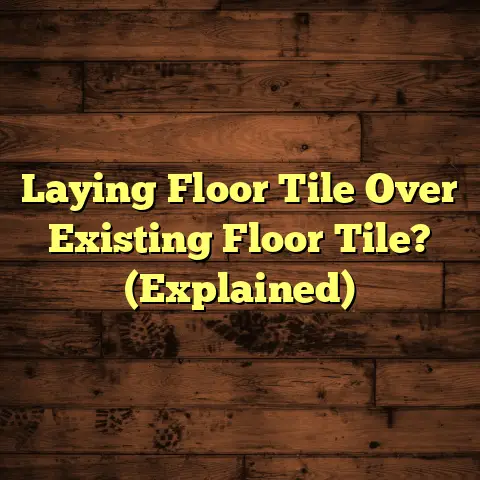Laying Lino on Wood: Know This! (10-Step Guide!)
As a flooring contractor for over 15 years, I’ve seen firsthand how the right floors can make or break a sale.
Buyers walk in, and the first thing they notice? Yep, the floors.
They’re looking for something low-maintenance, durable, and stylish – something that won’t send their renovation budget through the roof.
That’s where linoleum comes in.
It’s not your grandma’s outdated kitchen floor anymore!
Modern linoleum boasts incredible designs, mimicking everything from hardwood to tile, adding a touch of elegance that can significantly boost your home’s appeal.
I’ve seen homes sell for thousands more simply because the flooring looked fresh and modern.
One cost-effective way to achieve this is by laying linoleum directly over existing wooden floors. Intrigued?
It’s easier than you think, and I’m here to guide you through the process.
Section 1: Understanding Linoleum
So, what exactly is linoleum?
It’s a natural flooring material made from renewable resources like linseed oil, rosin, wood flour, cork dust, and pigments, all pressed onto a jute backing. Pretty cool, right?
This makes it an eco-friendly choice, something increasingly important to today’s buyers.
Think about it: you’re not just getting a floor; you’re making a statement about sustainability.
Benefits Galore
Linoleum is tough! It can withstand heavy foot traffic, making it perfect for busy families and high-traffic areas.
It’s also naturally antibacterial and easy to clean.
Plus, the design versatility is insane. You can find linoleum in virtually any color, pattern, or style you can imagine.
Busting Myths
I’ve heard it all. “Linoleum is cheap and ugly.” “It’s the same as vinyl.”
Let’s set the record straight.
Modern linoleum is anything but cheap-looking.
The advanced printing techniques create stunning visuals.
And no, it’s not vinyl.
Vinyl is a synthetic material, while linoleum is all-natural.
This difference is huge in terms of durability, environmental impact, and even the feel under your feet.
| Feature | Linoleum | Vinyl |
|---|---|---|
| Material | Natural, renewable resources | Synthetic, plastic-based |
| Durability | High | Moderate |
| Environmental | Eco-friendly | Less eco-friendly |
| Antibacterial | Naturally antibacterial | Not naturally antibacterial |
| Cost | Moderate to High | Low to Moderate |
Section 2: Preparing for Installation
Alright, ready to get started? First, gather your supplies.
You’ll need:
- Linoleum flooring (obviously!)
- Measuring tape
- Utility knife with sharp blades
- Straight edge or ruler
- Trowel (for adhesive)
- Linoleum roller
- Adhesive (more on this below)
- Sandpaper
- Vacuum cleaner
- Leveling compound (if needed)
Measuring and Calculating
Measure the length and width of the room.
Multiply those numbers to get the square footage.
Add about 10% extra for waste and tricky cuts. Trust me, you’ll need it.
Assessing the Wood Floor
Before you even think about laying linoleum, inspect your wood floor.
Are there any squeaks? Loose boards? Warping?
Address these issues before you proceed.
Squeaks can often be fixed by screwing down loose boards.
Warping might require replacing sections of the wood floor.
A solid, level subfloor is crucial for a successful linoleum installation.
I once skipped this step on a job, and the linoleum bubbled up within weeks. Lesson learned!
Acclimation is Key
Linoleum needs to adjust to the room’s temperature and humidity before you install it.
Unroll the linoleum in the room for at least 24-48 hours.
This prevents shrinking or expanding after installation, which can lead to gaps and other problems.
Choosing the Right Adhesive
Picking the right adhesive is critical.
I recommend using an adhesive specifically designed for linoleum.
Water-based adhesives are generally a good choice.
They’re low in VOCs (volatile organic compounds) and easy to clean up.
However, for high-moisture areas, consider a moisture-resistant adhesive.
Consult with your local flooring supplier for the best option for your specific needs.
Section 3: The 10-Step Guide to Laying Lino on Wood
Okay, let’s get to the good stuff! Here’s my 10-step guide to laying linoleum on wood like a pro:
Step 1: Clear the Space
Remove everything from the room. Furniture, rugs, curtains – the whole shebang.
You need a completely clear workspace.
Trust me, you’ll appreciate the extra room to maneuver.
Step 2: Prepare the Wood Surface
This is where the elbow grease comes in.
First, vacuum the floor thoroughly to remove any dirt, dust, and debris.
Next, sand the wood surface to create a slightly rough texture.
This helps the adhesive bond properly.
If the floor isn’t level, use a leveling compound to fill in any low spots.
Let it dry completely before moving on.
Step 3: Measure and Cut the Linoleum
Carefully measure the room again, paying close attention to corners and doorways.
Transfer these measurements to the linoleum, adding a few extra inches on each side for trimming.
Use a sharp utility knife and a straight edge to cut the linoleum.
Score the surface first, then make a deeper cut on the second pass.
Step 4: Test the Layout
Before you start gluing, lay the linoleum in place without adhesive.
This allows you to visualize the final look and make any necessary adjustments.
Pay attention to the seams and corners.
Make sure everything lines up correctly.
If you’re using patterned linoleum, ensure the pattern matches at the seams.
Step 5: Apply Adhesive
Fold back half of the linoleum.
Using a trowel, apply the adhesive to the wood floor in a thin, even layer.
Follow the adhesive manufacturer’s instructions for the correct application rate.
Don’t apply too much adhesive, or it will squeeze out from under the linoleum.
Step 6: Lay the Linoleum
Carefully roll the linoleum back into place, starting from the center and working your way outwards.
Use a linoleum roller to smooth out any bubbles or wrinkles.
Apply firm, even pressure to ensure the linoleum is fully bonded to the adhesive.
Repeat steps 5 and 6 for the other half of the room.
Step 7: Trim Excess Linoleum
Once the linoleum is in place, trim the excess material around the edges of the room.
Use a sharp utility knife and a straight edge to create a clean, professional finish.
Take your time and be precise.
A sloppy trim job can ruin the entire look.
Step 8: Roll the Floor
This is a crucial step!
Use the linoleum roller to go over the entire floor again, paying special attention to the seams and edges.
This ensures proper adhesion and eliminates any remaining air pockets.
Roll in both directions for best results.
Step 9: Allow the Adhesive to Cure
Resist the urge to walk on the floor or move furniture back into the room immediately.
Allow the adhesive to cure completely according to the manufacturer’s instructions.
This typically takes 24-48 hours.
Step 10: Finishing Touches
Once the adhesive is cured, you can seal the edges of the linoleum with a sealant.
This prevents moisture from seeping under the flooring and causing damage.
Install baseboards or quarter-round molding to cover the edges and create a finished look.
Section 4: Post-Installation Care and Maintenance
Congrats! You’ve successfully laid linoleum on wood. Now, let’s keep it looking great.
Regular cleaning is key. Sweep or vacuum the floor regularly to remove dirt and debris.
Mop with a mild detergent and water. Avoid harsh chemicals or abrasive cleaners, as they can damage the linoleum.
Place mats at entrances to trap dirt and moisture.
Use furniture pads under the legs of chairs and tables to prevent scratches.
Inspect the floor regularly for any signs of damage, such as scratches, dents, or tears.
Address these issues promptly to prevent them from getting worse.
For example, scratches can often be buffed out with a special linoleum polish.
Conclusion
Laying linoleum on wooden floors is a fantastic way to update your home’s look without breaking the bank.
It’s durable, stylish, and relatively easy to install yourself.
Plus, it can significantly enhance your home’s aesthetic appeal and, ultimately, its resale value.
I’ve seen it happen time and time again.
So, if you’re looking for a flooring option that’s both beautiful and practical, give linoleum a serious look.
You might be surprised at how much it can transform your space and impress potential buyers.
Happy flooring!





